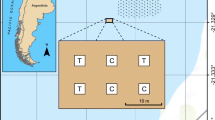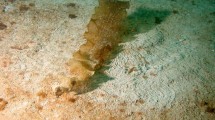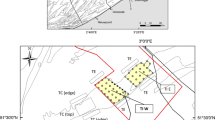Abstract
Over the past five decades, transitions from kelp beds (or forests) to barrens have occurred as a result of sea urchin overgrazing along the temperate coastlines. The deterioration of mature kelp beds has been mainly observed for Laminaria, Saccharina, and Macrocystis in the order Laminariales. In northern Miyagi Prefecture, Japan, the destruction of adult Ecklonia bicyclis kelp beds by the overgrazing of Mesocentrotus nudus was observed since 2013. In this study, we analyzed the process of deterioration of an E. bicyclis bed, from the changes in morphology of the thallus, with or without urchin grazing marks and urchin attachment, from video and photographic records. The processes of deterioration followed one of two strategies. In the first strategy, sea urchins climb from the stipes to the branches under calm conditions in winter. Subsequently, the fronds and branches are grazed by these urchins, as shown by large numbers of bare stipes and holdfasts. After the disappearance of the fronds and the branches, sea urchins mainly graze above the stipe bases, as illustrated by the high percentage of stipes with grazing marks. Finally, rigid holdfasts are left on the seafloor. The kelp bed is most likely to be destroyed by this grazing strategy. In the second strategy, urchins aggregate on the holdfasts of the entire plants and graze the stipe bases, particularly in February. The stipes are severely grazed by sea urchins, and the thalli above the stipe bases fall to the seafloor. Urchins aggregated firstly graze the fronds of the detached thalli followed by the branches and the stipes. The results of this study suggest that protection of the stipes from the grazing and climbing of M. nudus would be desirable for the conservation and restoration of E. bicyclis kelp beds.


Similar content being viewed by others
References
Agatsuma Y (1997) Ecological studies on the population dynamics of the sea urchin Strongylocentrotus nudus. Sci Rep Hokkaido Fish Exp Stn 51:1–66
Agatsuma Y, Kawai T (1997) Seasonal migration of the sea urchin Strongylocentrotus nudus in Oshoro Bay of southwestern Hokkaido, Japan. Nippon Suisan Gakkaishi 63:557–562
Agatsuma Y, Matsuyama K, Nakata A (1996) Seasonal changes in feeding activity of the sea urchin Strongylocentrotus nudus in Oshoro Bay, southwestern Hokkaido. Nippon Suisan Gakkaishi 62:592–597
Agatsuma Y, Matsuyama K, Nakata A, Kawai T, Nishikawa N (1997) Marine algal succession on coralline flats after removal of sea urchins in Suttsu Bay on the Japan Sea coast of Hokkaido, Japan. Nippon Suisan Gakkaishi 63:672–680
Agatsuma Y, Nakata A, Matsuyama K (2000) Seasonal foraging activity of the sea urchin Strongylocentrotus nudus on coralline flats in Oshoro Bay in south-western Hokkaido, Japan. Fish Sci 66:198–203
Andrew NL, Underwood AJ (1993) Density-dependent foraging in the sea urchin Centrostephanus rodgersii on shallow subtidal reefs in New South Wales, Australia. Mar Ecol Prog Ser 99:89–98
Bonsdorff E (1983) Appetite and food consumption in the sea urchin Echinus esculentus L. Sarsia 68:25–27
Breen PA, Mann KH (1976) Destructive grazing of kelp by sea urchins in eastern Canada. J Fish Res Board Can 33:1278–1283
Chapman ARO (1981) Stability of sea urchin dominated barren grounds following destructive grazing of kelp in St. Margaret’s Bay, eastern Canada. Mar Biol 62:307–311
Gagnon P, Himmelman JH, Johnson LE (2004) Temporal variation in community interfaces: kelp-bed boundary dynamics adjacent to persistent urchin barrens. Mar Biol 144:1191–1203
Hagen N (1983) Destructive grazing of kelp beds by sea urchins in Vestfjorden, northern Norway. Sarsia 68:177–190
Japan Agency for Marine-Earth Science and Technology (2016) Special, TEAMS. Blue Earth 141:20–23 (in Japanese)
Johnson C, Ling S, Ross J, Shepherd S, Miller K (2005) Establishment of the long-spined sea urchin (Centrostephanus rodgersii) in Tasmania: first assessment of potential threats to fisheries. Project Report. School of Zoology and Tasmanian Aquaculture and Fisheries Institute, Hobart
Johnson CR, Banks SC, Barrett NS, Cazassus F, Dunstan PK, Edgar GJ, Frusher SD, Gardner C, Haddon M, Helidoniotis F, Hill KL, Holbrook NJ, Hosie GW, Last PR, Ling SD, Melbourne-Thomas J, Miller K, Pecl GT, Richardson AJ, Ridgway KR, Rintoul SR, Ritz DA, Ross DJ, Sanderson JC, Shepherd SA, Slotwinski A, Swadling KM, Taw N (2011) Climate change cascades: shifts in oceanography, species’ ranges and subtidal marine community dynamics in eastern Tasmania. J Exp Mar Biol Ecol 400:17–32
Kamiya M (2012) Seaweeds illustrated. Seibundo Shinkosha Publising Co. Ltd., Tokyo (in Japanese)
Kawamata S (1998) Effect of wave-induced oscillatory flow on grazing by a subtidal sea urchin Strongylocentrotus nudus (A. Agassiz). J Exp Mar Biol Ecol 224:31–48
Lauzon-Guay J-S, Sheibling RE (2007a) Behaviour of sea urchin Strongylocentrotus droebachiensis grazing fronts: food-mediated aggregation and density-dependent facilitation. Mar Ecol Prog Ser 329:191–204
Lauzon-Guay J-S, Sheibling RE (2007b) Seasonal variation in movement, aggregation and destructive grazing of the green sea urchin (Strongylocentrotus droebachiensis) in relation to wave action and sea temperature. Mar Biol 151:2109–2118
Leighton DL, Jones LG, North W (1966) Ecological relationships between giant kelp and sea urchins in southern California. In: Young EG, McClachlan J (eds) Proceedings 5th International Seaweed Symposium, Halifax, Canada, 1965, Pergamon Press, Oxford, pp 141–153
Ling S (2008) Range expansion of a habitat-modifying species leads to loss of taxonomic diversity: a new and impoverished reef state. Oecologia 156:883–894
Machiguchi Y, Mizutori S, Sanbonsuga Y (1994) Food preference of sea urchin Strongylocentrotus nudus in laboratory. Bull Hokkaido Natl Fish Res Inst 57:81–86 (in Japanese with English abstract)
McDevit DC, Saunders GW (2010) A DNA barcode examination of the Laminariaceae (Phaeophyceae) in Canada reveals novel biogeographical and evolutionary insights. Phycologia 49:235–248
Muraoka (2008) Eisenia bicyclis bed coverage off Oshika Peninsula, Japan, in relation to sporophyte survival and Strongylocentrotus nudus abundance. J Appl Phycol 20:845–851
North WJ, Pearse JS (1970) Sea urchin population explosion in southern California coastal waters. Science 167:209
Perreault M-C, Borgeatid IA, Gaymer CF (2014) Impact of grazing by the sea urchin Tetrapygus niger on the kelp Lessonia trabeculata in northern Chile. J Exp Mar Biol Ecol 453:22–27
Rothman MD, Mattio L, Wernberg T, Anderson RJ, Uwai S, Mohring MB, Bolton JJ (2015) A molecular investigation of the genus Ecklonia (Phaeophyceae, Laminariales) with special focus on the southern hemisphere. J Phycol 51:236–246
Sano M, Omori M, Taniguchi K, Seki T (2001) Age distribution of the sea urchin Strongylocentrotus nudus (A. Agassiz) in relation to algal zonation in a rocky coastal area on Oshika Peninsula, northern Japan. Fish Sci 67:628–639
Scheibling RE, Hennigar AW, Balch T (1999) Destructive grazing, epiphytism, and disease: the dynamics of sea urchin−kelp interactions in Nova Scotia. Can J Fish Aquat Sci 56:2300–2314
Schlosser SC, Lupatsch I, Lawrence JM, Lawrence AL, Shpigel M (2005) Protein and energy digestibility and gonad development of the European sea urchin Paracentrotus lividus (Lamarck) fed algal and prepared diets during spring and fall. Aquac Res 36:972–982
Shigei M (1995) Echinozoa. In: Nishimura S (ed) Guide to seashore animals of Japan with color pictures and keys, vol II. Hoikusha, Osaka, pp 538–552 (in Japanese)
Vásquez JA (1991) Variables morfométricas y relaciones morfológicas de Lessonia trabeculata Villouta and Santelices, 1986, en una población submareal del norte de Chile. Rev Chil Hist Nat 64:271–279
Velimirov B, Griffiths CL (1979) Wave-induced kelp movement and its importance for community structure. Bot Mar 22:169–176
Walker CW, Unuma T, Lesser MP (2007) Gametogenesis and reproduction of sea urchins. In: Lawrence JM (ed) Edible sea urchins: biology and ecology. Elsevier, Amsterdam, pp 11–33
Yoshida T (1998) Marine algae of Japan. Uchida Roukakuho Publishing Co. Ltd, Tokyo (in Japanese)
Acknowledgements
We sincerely thank the staff of Youth Division, Miyagi Fisheries Cooperative Association, Shizugawa Branch, and M. Oshima and S. Kodama of Diving Stage Ariel for their supports of diving surveys.
Funding
This research was financially supported by “Tohoku Ecosystem Associated Marine Science” Ministry of Education, Culture, Sports, Science and Technology, Japan.
Author information
Authors and Affiliations
Corresponding author
Rights and permissions
About this article
Cite this article
Agatsuma, Y., Takagi, S., Inomata, E. et al. Process of deterioration of a kelp (Ecklonia bicyclis Kjellman) bed as a result of grazing by the sea urchin Mesocentrotus nudus (Agassiz) in Shizugawa Bay in northeastern Honshu, Japan. J Appl Phycol 31, 599–605 (2019). https://doi.org/10.1007/s10811-018-1503-5
Received:
Revised:
Accepted:
Published:
Issue Date:
DOI: https://doi.org/10.1007/s10811-018-1503-5




